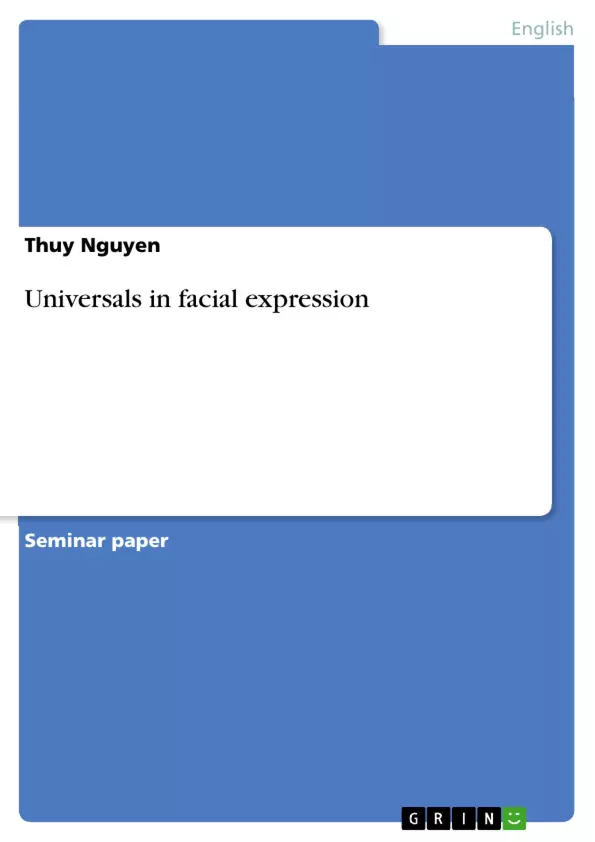This essay deals with the question whether facial expressions are universal meaning
that all cultures use the same mimics for expressing a certain feeling. Are these
expressions innate or do they have to be learned?
First, I will give an overview of Charles Darwin’s theory about the universality of facial
expressions because he was the first who dealt in detail with this issue.
The chapter is subdivided in three parts: the first part describes the relationship
between the facial expressions of nonhuman primates and human primates. The
following part deals with Darwin’s observations of the facial expression in infants and
children including those children that have no opportunity to learn facial expressions
from others. Finally, Darwin’s method of cross-cultural study in order to provide
evidence for his claim will be presented.
The second chapter depicts the behaviourists’ position that in contrast to the
Universalists’ point of view is based on the belief that all facial expressions are
learned and culturally bound.
The main chapter represents the most current and detailed research of facial
expressions. The studies of Paul Ekman and Wallace Friesen refer mainly to Darwin
but also consider the cultural aspect. They introduce a neurocultural theory of
emotions, showing that the facial behaviour itself is determined by biological factors
as well as by social factors. Further, I will give a summary of three important
experiments Ekman and Friesen conducted in order to proof that the facial
expressions for the six basic emotions are universal.
[...]
Table of Contents
- Introduction
- The Universalist approach - Charles Darwin
- the origins of facial expressions
- facial expressions of infants and children
- feral, institutionalised and blind children
- the method of cross cultural studies
- The culture specific view
- Klineberg and the issue of display rules
- Emblems and emotions
- The interactionist approach
- The neurocultural theory of facial expressions of emotions
- The recognition of the spontaneous facial expression
- The recognition of emotions in five literate cultures
- The recognition and expression of emotions in preliterate cultures
- Conclusion
Objectives and Key Themes
This essay explores the universality of facial expressions across different cultures. The main objective is to determine whether facial expressions are innate or learned, and if they are universal or culture-specific. The essay examines different theories and research on the topic, particularly focusing on the work of Charles Darwin, Paul Ekman, and Wallace Friesen. Key themes explored include:- The role of innate biological factors in facial expressions
- The influence of cultural and social factors on facial expressions
- The relationship between facial expressions and emotions
- Methods of studying facial expressions across cultures
- The universality of facial expressions for basic emotions
Chapter Summaries
The introduction introduces the main topic of the essay: the universality of facial expressions. It sets the stage for the exploration of different theoretical perspectives and research findings.
Chapter 2 delves into the Universalist approach, focusing on Charles Darwin's theories. It discusses Darwin's observations on the facial expressions of primates and their implications for understanding human facial expressions. The chapter also examines Darwin's method of cross-cultural studies, which he used to support his claims of universality.
Chapter 3 presents the culture-specific view of facial expressions, which argues that all facial expressions are learned and culturally bound. This chapter discusses the concept of display rules and how they influence the expression and interpretation of emotions across cultures.
Chapter 4 explores the interactionist approach, which combines both biological and cultural perspectives. It focuses on the neurocultural theory of emotions proposed by Paul Ekman and Wallace Friesen, which emphasizes the interplay between biological and social factors in shaping facial expressions. The chapter then summarizes three key experiments conducted by Ekman and Friesen to support their claim that facial expressions for basic emotions are universal.
Keywords
The key terms and concepts in this essay include: facial expressions, universality, culture, emotion, display rules, neurocultural theory, basic emotions, cross-cultural studies, Charles Darwin, Paul Ekman, Wallace Friesen, and primates. These terms represent the central focus of the research and are crucial for understanding the complex relationship between facial expressions, culture, and human behavior.- Quote paper
- Thuy Nguyen (Author), 2005, Universals in facial expression , Munich, GRIN Verlag, https://www.grin.com/document/115799



